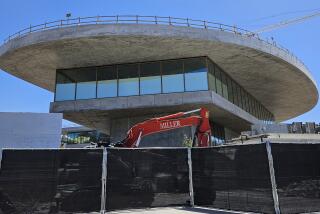Lanterman House: History in the Making : Heritage: The landmark is on the verge of becoming of a museum. The Planning Commission tries to appease some nearby residents who oppose the plan.
- Share via
LA CANADA FLINTRIDGE — The city is on the verge of opening its first museum, the historic Lanterman House, after the Planning Commission rejected arguments by neighbors who fear that a museum would bring traffic and disruption to their quiet residential street.
The famed house on Encinas Drive that once belonged to the late Assemblyman Frank Lanterman was bequeathed to the city to be made into a museum when his brother Lloyd died in 1987--the last of the family.
Built in 1915, the Lanterman House, on 1.3 acres of land, features inherited Victorian furniture along with gems of the ‘20s--an old gas stove, built-in icebox and white tiles on the floor and bathroom walls.
Eleven residents filed suit in 1989 to stop the museum proposal, but lost in court. The latest threat of lawsuits came last week when the Planning Commission tentatively considered rezoning the site of the Lanterman House for public use. Residents said if the house should ever be moved or demolished, the city then could use the site as a park or for any other public use.
After more protests from neighbors, the Planning Commission last week agreed to retain the residential zoning for the house, but with a conditional-use permit for a museum.
And to further smooth the ruffled feathers, the City Council on Tuesday night approved spending more than $2,000 to install about 25 street signs for restricted parking to help ease any increase in traffic on the neighborhood’s narrow streets. Restrictions are also placed on hours of operation and types of museum activities. The city will re-evaluate the signs in a year to see if they are working.
The museum is expected to sail through its last hurdle next week--the commission’ approval of a landscaping plan. The dedication ceremony is scheduled for Sept. 26. Gov. Pete Wilson and Frank Lanterman’s longtime friend, Assembly Speaker Willie Brown, are among the prominent figures invited. The museum is to open Oct. 1.
“It’s a dream come true,” said Sue Schechter, president of the Lanterman Historical Museum Foundation. “(The museum) is something I’ve always believed in. It’s a gift for the future generation--an opportunity for the children to see the history of La Canada firsthand.”
The nonprofit museum foundation was incorporated five years ago to guide development of a museum program and to raise money to renovate the interior.
In the meantime, a part-time caretaker hired by the city has been keeping the house in repair.
The Lanterman family history is closely tied to that of the community. In 1876, Dr. Jacob L. Lanterman, Frank and Lloyd’s grandfather, and a business partner bought the 6,000-acre eastern part of Rancho La Canada in unincorporated Flintridge.
Jacob Lanterman helped organize the La Canada elementary school district and, with his wife, Amoretta, donated the land and money to build the community’s first church.
In 1910, the family formed the Valley Water Co., which brought water to the community.
Two generations later, grandson Frank was elected to the Legislature in 1950. During his tenure, he sponsored legislation that brought Colorado River water to Flintridge, enabling a subdivision of the family estate.
Frank Lanterman died in 1981; his brother Lloyd died six years later. The Legislature voted $500,000 in 1987 for the home’s restoration into a museum, and recently agreed that the money will remain available until 1994. The city has agreed to pick up the balance of the $844,000 start-up cost for the museum, said City Manager Gabrielle G. Pryor.
The city also will pay the estimated $40,075 annual operating cost until the Lanterman Foundation takes hold. In 1990, the City Council approved a five-year operating agreement with the foundation, clearing the way for the restoration.
“It’s worth all the trouble. It’s part of the community’s character. . . . Every community needs a kind of grounding to know where they came from,” said Councilwoman Carol Liu, who lives a block from the mansion in an old farmhouse that once belonged to Jacob Lanterman.
Mayor James T. Edwards said he fully supports the museum but would like the foundation by next year “to live up to what it said it would” and start paying for the cost of running and maintaining the museum.
Meanwhile, the residents are willing to see what kind of neighbor the museum makes, said Kay Ryan, member of The Lanterman Neighborhood Committee.
“It’s an unknown. Everyone fears what you don’t know,” Ryan said. “As long as it sits there and it’s very quiet and it doesn’t bother us, that’s fine.”
More to Read
The biggest entertainment stories
Get our big stories about Hollywood, film, television, music, arts, culture and more right in your inbox as soon as they publish.
You may occasionally receive promotional content from the Los Angeles Times.










